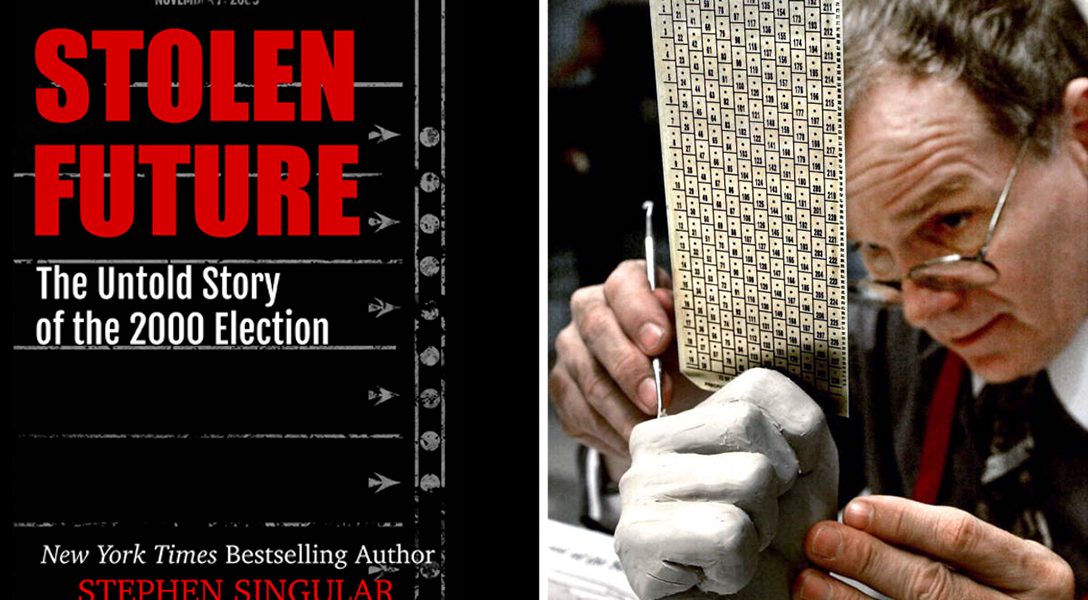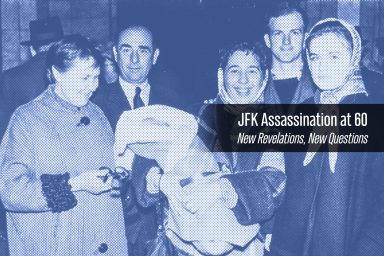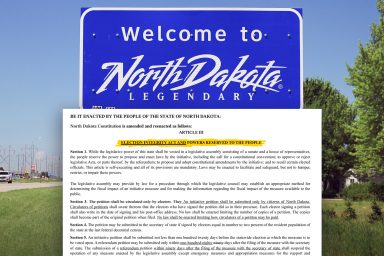It’s Not Just Who Votes, It’s Who Counts the Votes
How 1/5,000th of an Inch May Have Changed the World
Investigative journalist Stephen Singular talks about his book Stolen Future, and the great mystery that still surrounds the 2000 presidential election.
As a regular reader of WhoWhyWhy, you know that we have focused like a laser on election integrity and uncovered story after story about voter suppression in Georgia, Florida, Texas, North Carolina, and elsewhere. But important as all of this is, it’s only part of the bigger story.
It was Joseph Stalin who said that “it’s not the people who vote that count, it’s the people who count the votes.” The 2000 presidential election was a fantastic example of why that matters.
You all remember chads, hanging chads, punch cards, Votomatic machines, and how 540 votes and five Supreme Court justices changed America. What if those hanging chads had not been an accident? What if it wasn’t the fault — as was claimed at the time — of incompetent voters who didn’t know how to completely punch out a chad? What if the cards themselves had been engineered to fail?
In a never-before-told story that reads like a detective novel, investigative journalist Stephen Singular finds himself on the floor of the factory that made the infamous punch cards, in negotiations with 60 Minutes trying to get their help, and being given hundreds of unused punch cards to test as he tries to unravel the first great electoral mystery of the 21st century.
In this week’s WhoWhatWhy podcast, Singular talks to Jeff Schechtman about his just-published ebook Stolen Future: The Untold Story of the 2000 Election.
Singular takes us inside the machines that manufacture the perforated cards, whose precision, down to 1/5,000th of an inch, shaped the fate of the republic. Imagine that the war in Iraq could have been caused by a dull blade in one high-speed perforating machine in one factory, or maybe engendered by foul play.
Singular examines how the failure of punch cards not only impacted the 2000 election, but became the reason for states to place orders for hundreds of millions of dollars in new electronic voting systems — made by the very same private companies responsible for the 2000 mishap.
He tells Schechtman about ES&S, an Omaha-based company with close Republican ties and far-right roots, that manufactures most of the systems to which we entrust our vote.
Singular takes us inside 60 Minutes and their failure to pursue a story that may have been too hot for them to handle.
In the best tradition of investigative journalism, Singular’s journey goes from working with an old friend to test an idea, to having door after door slammed in his face. It’s a story that should add a sober new dimension to the efforts to preserve our democracy next week.
Click HERE to Download Mp3
Full Text Transcript:
As a service to our readers, we provide transcripts with our podcasts. We try to ensure that these transcripts do not include errors. However, due to time constraints, we are not always able to proofread them as closely as we would like. Should you spot any errors, we’d be grateful if you would notify us.
| Jeff Schechtman: | Welcome to radio WhoWhatWhy. I’m Jeff Schechtman. If you’ve been a regular reader of WhoWhatWhy, you know that our focus on election integrity has been relentless. You have followed the stories about voter suppression in Florida, Georgia, North Dakota, and North Carolina. But important as all this is, it’s only part of maybe only half of the story. It was Joseph Stalin who said that it’s not the people who vote that count, it’s the people who count the votes. |
| We saw in the 2000 presidential election, the degree to which that really matters. But even then, with the presidency decided by five Justices of the Supreme Court, did we really get the full story? Do we really know to this day what happened in Broward County or Miami-Dade? What did we learn? And more specifically, what did the people who counted the votes learn that may have impacted us in 2016 and may still be impacting us in just a few days? | |
| To give us insight to this part of the story, WhoWhatWhy has just published its first e-book entitled Stolen Future: The Untold Story of the 2000 Election. Its author is our guest today, Stephen Singular. Stephen, thanks so much for joining us. | |
| Singular: | Oh, thanks for inviting me. I appreciate it. |
| Jeff Schechtman: | Tell us how you first came to get yourself curious about the story. |
| Singular: | Well, I had followed, of course, the aftermath of the election and the Supreme Court decision and didn’t really think too much about it up until that point. But then I knew somebody as a friend in Florida who had voted in Broward County and who had voted with an absentee ballot, with the punch cards, and this individual happened to be a mechanical engineer. We’ve known each other for a long time. He called me and started telling me about his experiences as a voter, which was basically that he’d punched out his cards. He and his wife had, and they noticed that the chads, the little perforations that you punch out to signify your candidate had basically gone back in their holes. And he didn’t quite understand why that would happen. I mean, we know about the hanging chads and how they hang off the back of the piece of paper. We’ve all seen that, but these actually went back into the hole. |
| What that meant was if he hadn’t done anything else, and just mailed in his absentee ballot, it would have looked as if he’d voted for no one. But he was a curious fellow and an engineer, and very, very bright and he looked at it and said, “Well, that doesn’t really make sense.” So he punched it out again, and so did his wife, and they actually tore the perforations off of the cards and mailed them in, went on vacation, came back on November 7th or thereabouts, the election night of 2000, and watch this chaos unfold on television where the networks came out, as many will remember, and said that Al Gore was the 43rd President of the United States. I think it was, and that was what had happened, and that was based upon the polling that television networks have relied on for a long time. | |
| People vote, they come out, they ask them who they voted for, they do statistical extrapolations. It’s a very scientific thing. And in the past, it had worked. Suddenly something went wrong and the networks with great chagrin, came back on and said, “Well, we take back our projection. The vote totals seem to be changing for some reason, and we don’t really know who won.” Many of the problems were being generated in that Miami-Dade, Broward County, South Florida area, and all over the state in some instances, but heavily down there. | |
| My friend was watching this with his wife and the light went on and he thought, “Well, I wonder if other people either through absentee ballots or through voting at the polls on that night, that day, had had a similar experience.” Because what was coming in was what are called the number of undervotes, which means that it looks as if you didn’t vote for anybody because nothing is punched out or overvotes where multiple chads have been punched out and it looks as if you voted for three or four people or how many. | |
| As many listening here will remember. I mean, it’s set off absolute chaos and in terms of the presidential election, the networks were flip-flopping. We got kicked into the courts, very complicated situation because George W. Bush is running for president. His brother Jeb Bush is the governor of Florida. Bush’s confidant, let’s say is secretary of state, Katherine Harris, who controls what the time frame is for when votes will be counted and certified. They clearly were interested in shutting this down as quickly as possible and saying that George Bush won by about 541 votes. Yeah, 541 votes in Florida, which is obviously a tiny margin in the state with six million voters. And Gore had won the popular election as well. | |
| All of this was brewing for about six weeks. And then I started talking to my friend and he said, “Everybody’s talking about the machines that were used, the Votomatic machines, where the punch cards go through, and people are telling about the incompetence of voters, and they’re too stupid to figure out how to punch through a card and all of those things, but nobody’s talking about the cards themselves and how they actually performed.” He said, “Maybe you should come down here and look into this.” By that time, the legal situations were resolved on December 12, Bush was effectively appointed the President of the United States, as you said, by a 5-4 vote, and that does kind of clear, but a couple of things were happening. | |
| A number of people groups like the NAACP were suing various organizations in Florida over what had happened because a number of the discarded ballots had occurred in heavily African-American precincts. The Votomatic machines were being looked into and there were people rushing forward in the election systems business and saying, well, those punch cards don’t work anymore. Let’s rush in and sell all these disgruntled folks electronic voting machines. Florida itself bought about $70 million worth of that technology in order to get around this problem the next time. | |
| Jeff Schechtman: | While all this was going on, what did you decide to do next? |
| Singular: | I decided to go to Florida. My friend lived in Fort Lauderdale, which is very close to the elections warehouse where much of the equipment from the recent voting was kept. Not only the equipment, but the cards that had been used. And beyond that, the cards that hadn’t been used. So there were what we call virgin voter punch cards on the premises there and on almost a lark we decided to go in and see if we could get some of those unused cards and just start to examine them. |
| The interesting part of that, when I think back on it, is that we did go in, talked to the Supervisor of Elections, and he gladly and openly gave us a couple of batches of cards. When I look back on it, I think, they didn’t know what happened either. That was the thrust of everything these election officials said, is that “We’re getting blamed for this but we didn’t do anything differently from any other election. Now we’re in the crosshairs of lawsuits, bad jokes by comedians, just being trashed right and left, and we don’t know what happened.” And I think there was a little bit of curiosity on their part to say, “Well, if somebody wants to look into this, well and good, because we don’t have a clue.” That’s where the story really started, was going there, getting some cards, and then proceeding from there. | |
| Jeff Schechtman: | Was there a thought in your own mind that what happened may have been as much incompetence as anything mischievious? |
| Singular: | Well, yeah. It’s a very complicated story, and there are multiple explanations. One of the things I say is that it’s not that we do know what happened, it’s that we still basically don’t know, and that’s the crux of this story, that there were opportunities to learn more and they weren’t really developed. When you look into the punch card arena, the way they’re manufactured is that the paper is fed through an assembly line basically, and they’re hit with a stamping wheel which makes the perforations on the card. |
| In Broward County, it was 228 of those little perforations, in Miami-Dade it was 312. But those things are calculated down as I would learn, to about 1/5,000th of an inch, so you’re dealing in microscopic differences in how those machines function and they become dull through usage as any machine does. There’s always a margin for just incompetence or human error or machine error in that card making process. It was rather startling for me to learn that our election system sort of hangs on that 1/5000th of an inch. I’d never even imagined anything like that before getting involved in issues or think it would be a little more protected than that. But that was coming straight from the election officials. | |
| We got the cards. My friend began to test them on his own. We were looking for a piece of equipment called a strain gauge, which is what measures downward pressure as it’s measured in grams. There’s this industry standard for cards that is basically 150 grams to 350. So when you’re applying that pressure downward, the chad should come out. We had cards from two major manufacturers. One was Sequoia Pacific from California, and one was from ES&S based in Omaha, Nebraska. And the great bulk of the cards in Broward and Miami-Dade had come from ES&S. | |
| We wanted to see if there was any variation in the cards, variation in the chads, variation in how they might have behaved when you were putting pressure on them. Would they fall out easily? Too many would fall out creating an overvote. Would they be very difficult to push out? And then if you push it out would the chad go back in, as it apparently happened in widespread cases in the election causing an undervote. There were approximately 200,000 of these votes, overvotes and undervotes, in the election itself. As you will recall me saying a few minutes ago, Bush was apparently or allegedly ahead by 541 votes. Razor thin margin, obviously. What was contained in those 200,000 votes that were tossed aside? | |
| What drove this was that in Miami-Dade, if you were looking at some of the African-American precincts, there were 9000 votes that were thrown out, based upon on what I was just saying. They voted 10-1 for Al Gore. That would be nine, nine out of 10 would be 8100 votes, Bush is ahead by 541, you can do the math. The point being obviously highly contested, what really happened here? And was there any possibility that cards could be produced to behave in a certain way, so that you would in fact get undervotes or overvotes in certain precincts that could possibly be targeted. That became the overriding and compelling question of the investigation. | |
| We got the cards, we ran some tests. They were preliminary, and we were not utilizing the most sophisticated equipment. There appeared to be some variation in the cards from one manufacturer to another, and there appeared to be some variation in how the chads behaved on some of the cards. But this is highly technical stuff. And after a week or so, I decided that we had to have much more muscle involved in what we were doing. This is around the seventh day of January, of 2001, which is to say it’s about 13 days before the George W. Bush administration will take office. If something happened that had helped cause some of these problems from an intentional perspective, and if it made the entire election really illegitimate, or even if it just needed to be investigated further, all of these things are totally in play by January 7. I thought, we potentially have a very large story here and we need to get some help. | |
| Jeff Schechtman: | You were two guys in Florida trying to test these cards. Where did you think any help was going to come from? |
| Singular: | I knew somebody at 60 Minutes, CBS, and had worked with this individual in the past and made a call. That person called Mike Wallace, the renowned anchor of CBS, 60 Minutes, and within a few hours we had kick-started a process there for they would look into this and maybe do something with it. A huge leap forward. One of their people or a couple of their people went to Florida, met my friend, got some of the cards, I think, got some more of the cards and began the process of testing them in a much more sophisticated way than we were capable of doing. |
| It looked as if by early January like this story, something could really happen here. They were putting time and resources into it. At the same time, I was running headlong into sort of a major media meat grinder there in that I had never exactly dealt with media people at this level. And what I’m saying is that I was basically told the moment I make that first phone call and hand this off to 60 Minutes, I will forever be cut out of the loop of what happens after that. It was one of those crossroads moments as a journalist where you don’t quite know what to do. The clock is ticking, the issues are very complicated, you don’t have the financial resources to go engage a major lab and do the kind of testing that needs to be done, so you reach out for help. And basically, there was just a line drawn in the sand that says: “We’re in, you’re out.” | |
| That becomes a part of the story going forward because they did test the cards. I tried to communicate, I tried to learn more about what was going on, and I was totally and completely shut out. It becomes a muddy area after that. I know that the cards are tested, I know that developments were going on around this, and I know that that went on, so that leads me to believe that they were learning things about the cards at a very intricate level that were important while they were doing that and they told me that I couldn’t do anything. In other words, I couldn’t investigate any further, I couldn’t talk to anybody in the card industry. I gradually became very annoyed with that and decided to just keep working on my own. | |
| I went to Dallas, outside of Dallas to the ES&S manufacturing plant. I talked my way in there through one thing and another and got on the factory floor to see how these cards were actually made, and to try and talk to some of the people there and learn more about it. I saw it was very critical to do that, in order to get any grasp of the technical understanding of this. I was given a brief tour of the factory. I was asking some rather pointed questions about what had happened in Florida where they had sold 4 million cards to Miami-Dade County and 1.5 million to Broward County prior to the 2000 election. | |
| Over time, over a brief period of time, I became aggravating to the man who was showing me around and he basically showed me the door. But I was able to see, and he was the man who told me point blank that as he put it, we live in a 1/5000th inch world. In other words, we’re a variation of 1/5000th inch on a stamping wheel that perforates those cards could basically … The fact how the card behaves once it’s in the voting booth in the counting machine and that was a very eerie thing for me to hear. I mean, we just had a president basically selected by the Supreme Court based upon what appeared to be the fragility of our voting system. I think history pivoted right there in front of us, and that was the whole impetus in this. | |
| If there’s more to this story, we have to get it out there. We have to figure out what happened. Not only because of what the result was in the 2000 election and what that implies for our politics going forward, but all of these companies, as I said, these voting system companies are coming in and they’re selling electronic equipment to replace the punch cards. Well, we can all understand how a punch card works, but there are very few of us that understand the intricacies of computerized voting. Again, I thought this is a major issue. What if we’re replacing a system where we don’t even know what the problem is yet. We need to answer these questions. | |
| Jeff Schechtman: | What happens next at this point? |
| Singular: | The story proceeded from there. I was told repeatedly, CBS, 60 Minutes is going to do something, “We’re going to get it on the air. We’re going to have something.” That was all I was told. And they never knew that I went to Dallas and got on the floor of that factory. If they had, they would have been very upset. They never ran the story, they never communicated with me what they uncovered, but I am quite certain that they uncovered certain things. It sort of began to trail off. And then if you can put yourself back in June-July, of 2001, George W. Bush’s ratings were down, everything was stagnant, and all of that, the story still seemed to be unfolding behind the scenes. |
| And then, of course, we got 9/11 and everything that I was working on, or I think that others were working on, just sort of died. Nobody was going to now criticize George Bush or how he was elected, or what was involved in that. Again, as I said, the world sort of pivoted in this nine month, 10 month framework where … And then everything that happened after that happened. | |
| Jeff Schechtman: | You argued that this story has ramifications that go beyond the 2000 election, that it even goes into the 2004 election. Explain that. |
| Singular: | The story didn’t die. If one wants to delve into the 2004 election where the key state was not Florida but Ohio, John Kerry was leading in Ohio, which was the pivotal state in the election. Whoever won it was going to win the 2004 presidential election. They now had installed not punch cards, but an electronic voting system. At 11:14 PM they hit in the polls, that the system crashes or goes down. It comes back up a few minutes later, and he’s behind, and he loses the election. |
| That is one more chapter in the story. And then of course, what really caused me to revive the story and to look into it was the election of Donald Trump in 2016. I’ve laid all this aside, and it was dormant. I told people back in 2001, well, what if some group gets their hands on the electronic voting system or some aspect of it and tries to manipulate the election in that manner? If you really delve into the 2004 election, that appears to be the case. It’s not really what I wrote about here, and others have written about it in far greater depth and know more about it than I do. | |
| Jeff Schechtman: | And as you see it, what’s the ramifications even in 2016? |
| Singular: | We get to 2016 and Hillary Clinton wins the popular vote by 3 million votes. And every poll is wrong, every poll is dead totally wrong, which is what happened in Florida, which echoes that, which tells me that more is going on here than meets the eye. Because polls are quite accurate and I thought, let’s see if I can revive this story and tell it and maybe there’s … Enough things have gone wrong around this issue and enough is at stake where three of the past five presidential elections in the United States are at best questionable, and at worst a lot more than that. |
| And I went to WhoWhatWhy, and Russ Baker, and I found a receptive group there, and I greatly appreciate the fact that they were willing to bring this out. Because I think it shows how important this issue actually is, how it is, how it’s been in the recent past, how it is now, and how it will be going forward. | |
| When polls are strikingly wrong, I think you have to look into the voting aspect itself, not just saying that people went on Facebook and put up fake news and that kind of thing. I think it’s a lot deeper than that. If you grew up like me, really believing in investigative journalism and the power of it, and this is when we really needed it the most, was in my view, in 2000. The media has changed over the years, and there just isn’t that much emphasis on that anymore. I sort of ran into that headlong, and I think if we had gotten to the bottom of it, the whole history of the past 17 or 18 years might be different. | |
| Jeff Schechtman: | One of the things that you talk about is that in each of these stories as this evolves, there really are different voting systems that are at play. There was the Votomatic system with the punch cards that we’re talking about in 2000, then the electronic voting, the kind that came after that that was really part of the debate in 2004, and then it all moved to this optical scan system later in 2016. Talk about that and the broad framework of the fact that while the systems are different, a lot of the players and a lot of the companies and all of these systems are exactly the same. |
| Singular: | Yeah, the main company that I focused on was this ES&S out of Omaha, and they were very much involved in the punch card situation in Florida in 2000 even though two days after the election they put up something on their website that said their systems were not really used. It’s a very curious turn of phrase. Their systems may not have been used but their cards were, and their cards were absolutely the issue. Then again what happened in Florida was that they rushed in, Jeb Bush, his first choice as Governor of Florida for the Secretary of State was not Katherine Harris but another woman named Sandra Mortham, who was a lobbyist, paid that lobbyist I believe before ES&S. |
| It was all very entangled, well after the punch card fiasco, ES&S sold $70 million worth of voting equipment, electronic voting equipment to Florida where Bush was governor. Then you’ve got the Democratic primary of 2002 and Janet Reno was running. I think the opponent was named McBride. I’m a little foggy on that. But then you had electronic voting and the same things happened just from a different angle. Votes weren’t being counted, the system malfunctioned, and they didn’t know who won, and there was a deadline to make a decision. Janet Reno in the confusion just caved in and said, “Okay, I’ll let the other guy win.” And so that’s what happened. It didn’t solve the problems and it created more and probably more intricate problems with that kind of voting system. | |
| Then you go to 2004, as I said, and people would have to do a little digging in and on their own with that, but people with were very strong republican ties were tied into the backup system that came up when the first one went down at 11:14, the night of that election. I mean, again at very best, it’s just a totally questionable part of our history. A man named Richard Hayes Phillips wrote a book about it and went into far greater detail than I have and shows you how the numbers shifted after the system came back up and all of that. Two elections right in a row where you don’t really know who won the presidency and I would, without going too political, I just think these are crucial things. There are major, major consequences that come out of these elections. | |
| You’re just trying to hold up a stop sign here and say, “How can we fix this? When do we get to the bottom of it?” | |
| Jeff Schechtman: | Getting back to the punch cards and what you discovered about them in the limited amount of time you had, in the limited testing that you did with this, you said, kind of primitive equipment, did you find any difference between the cards that were produced by ES&S and cards that were made by other companies like Sequoia? |
| Singular: | What we found was that my friend was the one running it, and he was an engineer, and he understood it better than I did. He blew the photos of the chads up 30 times so we could get a better idea of how much paper this very intricate stuff was holding on each chad. What he found was that there were some differences that he detected on the ES&S cards compared to Sequoia Pacific which seemed to be rather consistent in how they behave. But what he found most intriguing was that all of the chads came out in a similar way, and that did not appear to him to be a random situation. In other words, they could come out bottom to top, side to side, all of that sort of thing, and they were coming out in a consistent pattern that he called garage door, meaning that the two bottom areas swung up to the top. And then they fold it back in their holes as we talked about it. |
| He thought that that was perhaps not entirely random, and he just started raising what I thought were all of the right questions about how had this been made, and could these kinds of variations be built into the cards when they were being produced? I go into more detail about this in the book and the intricacies around all of that. He thought, and I thought, not that we had found the holy grail, but we had found enough that it needed to be looked into in more depth. I think given everything that had happened, and that there was absolutely no explanation for the malfunction of the 2000 presidential election, and that’s what you have to remember as you go back. Again, you’re blaming black people because they didn’t vote properly in Miami-Dade. You’re blaming elderly people in Broward County because they didn’t know how to vote. You’re blaming the machines, you’re blaming everything. | |
| There was no reasonable explanation on the table for why any of this happened. We thought this was a potential doorway into understanding that, and that’s why we took the actions that we did. His discoveries, I think, were preliminary findings like in any investigation that require more investigation. And that’s the point we got to. I wish I could say I have the definitive answer here for you, but I think if we’d gone down that road, we would have learned a lot more relevant information about this. | |
| Jeff Schechtman: | Did you have a theory or did your friend have a theory about how this might have been manipulated, that in fact, if this was the case with the cards, that it would have done it for Republican punches or Democratic punches, Gore or Bush punches. How could this have been manipulated? |
| Singular: | Well, our understanding, which was somewhat limited, was that you could potentially just program it into how … When I was on the factory floor, when you’re standing there and you’re watching this stamping wheel going around at incredible speeds making the perforations in the cards, there were some understanding that that could be manipulated to create variations in the cards. That’s what we were looking into. I was taken into a room where they examine these cards in great detail and I wanted to stay there with this man who was showing me around and say, “Show me the finest intricacies of the cards as they’re made through something called an optical comparator. I want to see the variations here and all that.” And he grabbed my arm and dragged me out of the room and subsequently very quickly got me out of the whole building. |
| So that was the fundamental question. Could you build variations into these things in the production process? We speculated on that. But again, that’s what CBS, that’s what 60 Minutes was investigating. And that’s the information that we never got to. | |
| Jeff Schechtman: | The other question, I guess, is that if you could build the variations in, you could deliver certain kinds of cards to certain areas and other kinds of cards to other areas. |
| Singular: | Well, what we learned was that, and this came from the election people in Florida, was that the voting card manufacturers know ahead of time where the cards are going, what precincts they are going to, and what the voting habits are in those precincts. So yes, it’s an absolutely relevant question. They have a map, basically, of the voting before the cards are ever made. And so they have that information. The cards are coded in a particular way for each precinct so that they’ll know where those cards are being used on election night. They have that ahead of time, and that’s the first question. The next question becomes, could you then build variations in, based upon that knowledge? |
| Jeff Schechtman: | Talk a little bit about the security of these cards. When you first started talking about walking in to where the cards were stored, and then being in the factory where they’re made. What kind of security existed for all of this? |
| Singular: | Well, none. There was none as far as we were concerned. I called the election supervisor in Broward County and he said, “Yeah, come on in.” And then again, to my amazement, he just handed the cards over. That was totally not secure. Talking my way into the factory in Dallas was a lot harder. When I began to ask really penetrating questions about the variations on the chads and the specific cards, they said they had specifications for all those things. I said, “Well, can I see the specifications that were used for Miami-Dade County and Broward in the Florida election?” “No. All that’s off limits.” |
| It wasn’t hard to get into their factory, but once they realized that I was there to ask some pretty piercing questions, they shut it down real fast. I would assume that security is probably tighter now than it was then, but those people were on edge in the wake of that election. | |
| Jeff Schechtman: | You spend a lot of time in the book also talking about ES&S, and a little bit about the company, people that were involved in its history. Talk a bit about that. |
| Singular: | They’re based in Omaha. They are a privately held company. They have major ties to the Republican Party. The count, I think, about that time was about 100 million votes a year. There have been numerous issues raised around the company for years with their electronic voting. WhoWhatWhy does an article every now and then about it. |
| A controversy has swirled around it because it seems to be a heavily republican company. Again, these are the people making the election systems, making the cards, controlling all of that. They’re privately held so it’s hard to get any information out of them at all. And again, it just raises these uncomfortable questions about who’s controlling our election system. Again, I mean, there seems to be a rather consistent pattern here. Gore goes down in 2000, Kerry goes down in 2004, and Hillary goes down in 2016. It’s obvious who’s on the winning side here. Again, I don’t offer readers all the answers, but I think we got to start asking the pertinent questions. | |
| Jeff Schechtman: | What is your theory and what does your gut tell you with respect to what happened regarding 60 Minutes? Did they lose interest in it? Did 9/11 cause them to lose interest in it? Or did something else potentially happen? |
| Singular: | I think that there were a lot of issues afloat there. I think they were somewhat afraid of the story. I think the story was maybe a little too much. I mean, you got to pull back and think about it. I mean, you were talking about the potentially fraudulent election of an American president after he’s been installed in office. This was an incredibly explosive story if it had blown. I think it was a hard story to prove based upon an examination, purely an examination of the cards, because again, you could always simply say, well, the blades got dull and they created these variations. That’s always the fallback position. |
| After a while, they said to me, what we need is somebody from the factory or somebody in the election system who will come forward and talk about this on camera. If you think about the movie The Insider, if you’re familiar with it, or the people listening are familiar with it, that involves tobacco. Tobacco is a big story, the fraudulent election of the President of United States is a bigger story. We came out of this without knowing what we needed to know, but what we do know is that our election system has been increasingly fragile over the last 17 or 18 years. If we had gotten to the bottom of this at the appropriate time through the appropriate channels with the right people, our entire history of the last 17 or 18 years might look very different. | |
| Jeff Schechtman: | Did you ever get to the bottom of what really happened with 60 Minutes? |
| Singular: | Ultimately, what 60 Minutes wanted was somebody to come on and spill the beans on everything and just lay it out for a lay audience so everybody could understand it. I was told, and this was later, this was years later, it wasn’t right then, that eventually they found somebody who was willing to do that. I heard this from multiple sources, but they couldn’t work out the details of the legalities of talking about it and that’s a very complex thing. The person wanted to be indemnified against any legal action that might come as a result of talking about this, very similar to what happened in the movie, The Insider, where Russell Crowe, his character didn’t get that kind of protection. Maybe this person was aware of that and asked for it, couldn’t get it, and nothing happened as a result of that. |
| Jeff Schechtman: | Stephen Singular. The book is Stolen Future: The Untold Story of the 2000 Election. It’s available in e-book from WhoWhatWhy. There are numerous links here on the page. |
| Stephen, I thank you so much for spending time with us. | |
| Singular: | Thank you very much. I appreciate it. |
| Jeff Schechtman: | And thank you for listening and for joining us here on radio WhoWhatWhy. I hope you join us next week for another radio WhoWhatWhy podcast. I’m Jeff Schechtman. If you like this podcast, please feel free to share and help others find it by rating and reviewing it on iTunes. You can also support this podcast and all the work we do by going to whowhatwhy.org/donate. |






